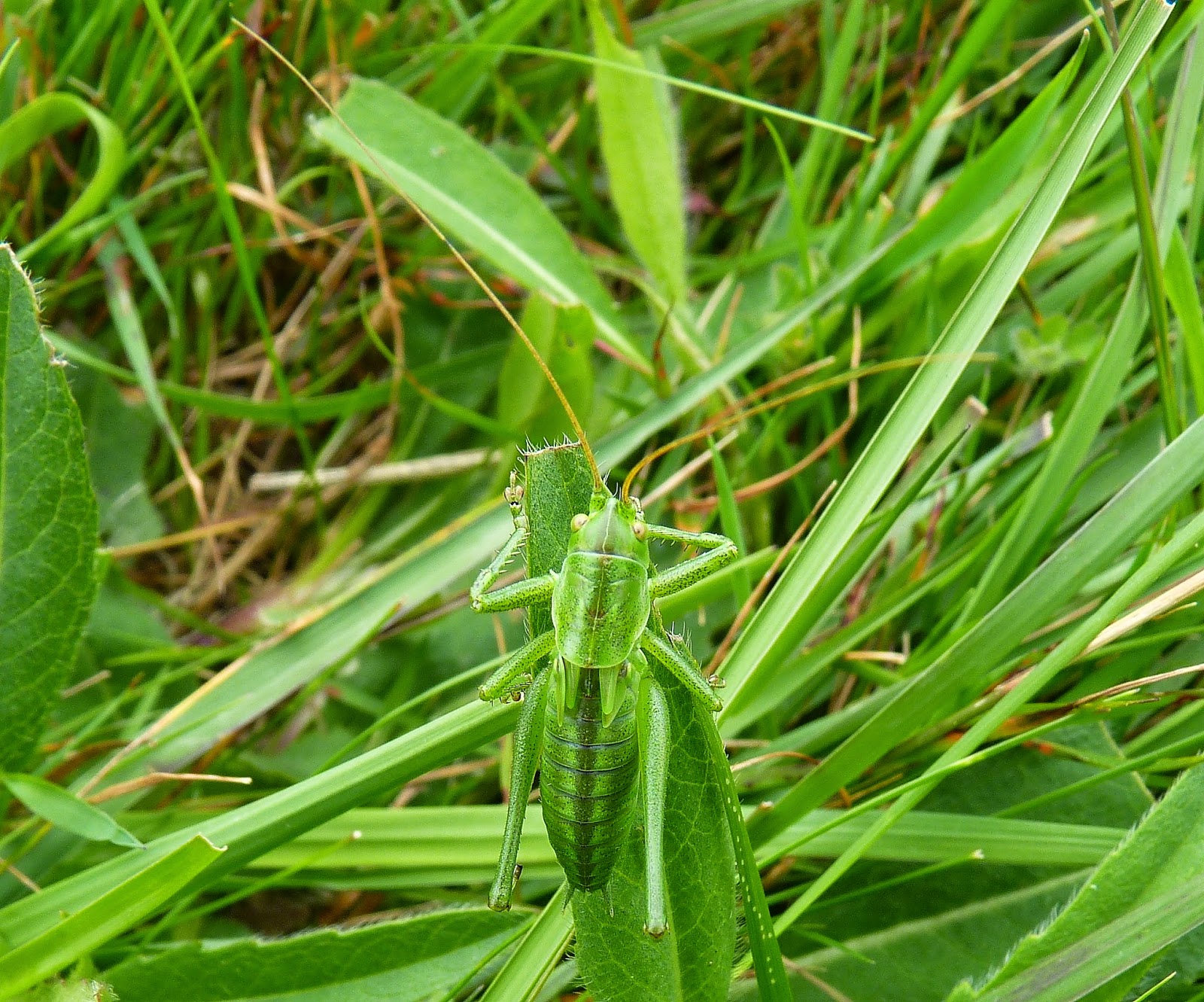This is the best time of to the year to go out & look for the members of the Grasshoppers, Crickets & Allies family. The family can loosely be split into Grasshoppers, Crickets, Bush Crickets, Locusts & Cockroaches. When I first started looking at this group, the definite book was the expensive (& well outside of my budget in those student days), Grasshoppers, Crickets & Cockroaches of the British Isles by Ragge. One of my mates had a copy & I can remember a number of visits to the New Forest when the birding was quiet, trying to find some of the better heathland & bog species. After moving back to Dorset, I got interested in the group again, but still struggled along without a field guide for several more years, until I came across A Photographic Guide to the Grasshoppers & Crickets of the British Isles by Martin Evans & Roger Edmondson. This is a companion volume to their excellent Shieldbugs book. More recently, I just bought The Grasshoppers, Bush-crickets & Allies of Dorset by Bryan Edwards, which has good sections on identification as well as excellent distribution maps. Both of these books are reasonably priced. As with most groups of wildlife, Dorset is an excellent place to seen these species with its good selection of species found in its chalk & limestone grasslands, heaths & woodlands habitats.
In this post, I will keep to the easier groups to get started on which are Bush Crickets, including the Coneheads. Twelve species have been recorded in Dorset. Of these Wart-biter has probably died out since the turn of the century, Large Conehead is known from 3 records found in 2005 & 2006 & Southern Oak Bush Cricket has recently been found around Portland Bill & Bournemouth from 2009 onwards. The remaining 9 species are more widespread in the county.
Roesel's Bush Cricket: A relatively recent species to arrive in Dorset with the first record in 2005. Since then it has moved steadily westwards, but is still scarce in the Purbeck area. The broad yellow edge to the side plates of the pronotum and the yellow spots on the side of the abdomen separates this from other Bush Crickets. Middlebere (7 Sep 14)
Long-winged Conehead: Male Nymph. Hatch Pond (24 Aug 14)
Long-winged Conehead: Female Nymph. Brands Bay (24 Aug 14)
In this post, I will keep to the easier groups to get started on which are Bush Crickets, including the Coneheads. Twelve species have been recorded in Dorset. Of these Wart-biter has probably died out since the turn of the century, Large Conehead is known from 3 records found in 2005 & 2006 & Southern Oak Bush Cricket has recently been found around Portland Bill & Bournemouth from 2009 onwards. The remaining 9 species are more widespread in the county.
Oak Bush Cricket: A fairly common & widespead species across Dorset. I have even seen it several times in the garden, but not since I've had the camera (so no photo at the moment)
Great Green Bush Cricket: Half grown male nymph. Corfe (9 July 12)
Great Green Bush Cricket: Female. At 2 inches long, this is the UK's largest Bush Cricket. It is widespread in Dorset. Swanage (9 Aug 14)
Great Green Bush Cricket: Half grown female nymph. Females are easy to identify due to the large ovipositor. St Aldhelms (1 July 14)
Dark Bush Cricket: Nymph. This is a common sight in the garden in the early Summer. Despite only having a quarter inch body, they look just like the adults apart from the disproportionally long antennae. That is pea gravel in the photo. Swanage (21 June 10)
Dark Bush Cricket: Adult male. This is the most widespread Bush Cricket in Dorset and is short-winged with a dark chocolate colouration. Swanage (5 August 10)
Grey Bush Cricket: This species is only found along the coastal strip and likes short, clifftop grassland. It doesn't venture inland. It is superficially similar to Dark Bush Cricket, but has long wings and is a mottled grey and brown colour. Jurassic Coastline near Winspit (31 Aug 14)
Bog Bush Cricket: A local species on the Dorset heaths & another one I've yet to photograph
Long-winged Conehead: Male Nymph. Hatch Pond (24 Aug 14)
Long-winged Conehead: Female Nymph. Brands Bay (24 Aug 14)
Long-winged Conehead: Adult male. The first Long-winged Conehead was found in Dorset in 1953. It remained fairly localised until the 1980s, when it suddenly started to expand its range to occur over much of the Southern half of Dorset. It is a common rough grassland species and is easily found in the Autumn. Note, the long wings which go beyond its abdomen. Swanage (9 Aug 14)
Long-winged Conehead: Adult Female. Note the obvious ovipositor. Hatch Pond (24 Aug 14)
Short-winged Conehead: This species looks similar to the Long-winged Conehead, but its wings are short and only half the length of the abdomen. It prefers wetter habitats than Long-winged Coneheads and the Poole Harbour basin, the Fleet and some of Dorset's river systems are its strongholds. It is another species I've still to photograph
Speckled Bush Cricket: Nymph. Again a fairly common Dorset species. This species is heavily speckled with black dots. The nymph is wingless. Swanage (2 July 2011)
As with other insect groups I've been getting into in recent years, the Grasshoppers, Crickets & Allies are a group I'm trying to broaden my knowledge of. I'm sure in a couple of years, I will be able to come back to write a more thorough post of this group. I will leave the more tricky to identify Grasshoppers part of the family for a future date, as this is the part of the family I'm still struggling to get into at the moment.











